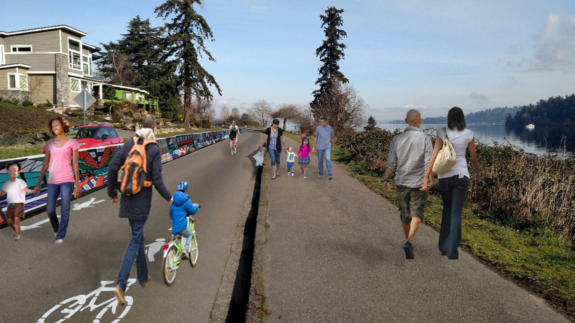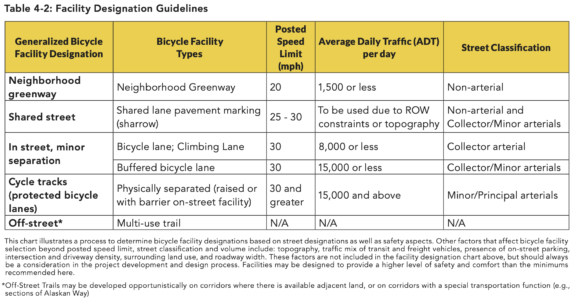Seattle needs a permanently safe space for biking and walking on Lake Washington Blvd
 Concept image for a low-cost biking and walking path on Lake Washington Boulevard from Seattle Neighborhood Greenways.
Concept image for a low-cost biking and walking path on Lake Washington Boulevard from Seattle Neighborhood Greenways.After a failed attempt at convening a task force to discuss ways to make Lake Washington Boulevard safe for people walking and biking, Seattle Parks is now preparing to make some small adjustments to the street that fall far short of what is needed and what the vast majority of people have said they want to see during years of public outreach and surveys.
Seattle Neighborhood Greenways is urging people to submit a comment on the project both supporting the near-term improvements and pushing for permanent walking and biking space. This feedback website is a bit annoying, requiring users to create an account, verify your email and fill out an info form before commenting, but power through it to make sure your comment is heard. Here are their suggestions for what to say:
Comment on the short-term improvements: (or upvote here)
- Identify locations where new pedestrian crossings or other safety improvements are needed.
- Request traffic calming measures like speed humps, raised crosswalks, or all-way stop signs.
- Short term safety improvements need to happen faster - before the summer of 2024!
Comment on what you'd like to see for next summer's Bicycle Weekends: (or upvote here)
- Improved signage, including detour information, and more effective barriers for vehicles.
- More community celebration such as music, food trucks, or art.
- Rebrand Bicycle Weekends to be more inclusive of the ways people use the Boulevard during Open Streets events.
- More frequent Bicycle Weekends, and for longer periods of time. Include holidays.
Comment on your long-term vision: (or upvote here)
- One-way vehicle traffic with barriers at the center line and a wide multi-use trail on the waterfront side of the street.
You can also join the SNG Lake Washington Boulevard Workgroup to get even more involved.
A failed task forceAfter watching some of the recordings from the Lake Washington Blvd. task force meetings and speaking with some of the people involved, it sounds like this process was a miserable experience for everyone. Several members stopped attending altogether. From the very start, nobody seemed to have any intention of listening to each other or changing their minds. After failing to come together around a positive vision for the street, the group ended up voting on ideas, several of which were shot down or tied because they took the vote while a pro-biking and walking member was on maternity leave. If you have a lot of patience, you can watch the meeting recordings yourself. For example here is the vote on creating a separated biking and walking space, which came more than two hours into the final task force meeting. The word resentment" comes up, which seems to capture people's feelings by this point.
This is not the kind of process our city should be basing major decisions around. Even just the idea of the task force voting is absurd because that's not supposed to be the point of such a process. We didn't elect these members, and this was not a democratic body with representative membership. It was a group of people chosen specifically because they had differing opinions on the street, and it was convened to talk through ideas and attempt to find some common ground. It failed to do so, but all that means is that this task force process failed. The group should not have had the ability to effectively veto ideas through a vote. That makes no sense.
But that's how Seattle Parks is treating the results, which is why they are only planning a handful of non-controversial things like a few new stop signs or speed humps. This was supposed to be a visioning process," and you know you have failed when your proposed solutions do not meet a single person's vision" for a better Lake Washington Boulevard.
I kept putting off writing about all this until now because I have nothing nice to say about it. Between 2015 and 2022, there were 101 reported collisions between people biking and driving on this street. People need to be safe. This is the most important job of every city department. Lake Washington Boulevard is not safe, and a couple stop signs and speed humps will not make it so. Worse, SDOT knows this. They have guidelines for what kinds of streets will work as neighborhood greenways, which is the type of facility where simple traffic calming is considered enough to make it safe for people of all ages and abilities to use. The traffic volumes on Lake Washington Blvd. are way beyond the city's guidelines. Below is the table from the Bicycle Master Plan, which was unanimously approved by the City Council (including then-Councilmember Bruce Harrell):

The city's own guidelines recommend neighborhood greenways only on streets with non-arterial designations that have 1,500 vehicles per day or fewer. According to SDOT's annual Traffic Report, Lake Washington Blvd. carries 7,400-8,400 vehicles per day, as much as 5.6 times as many as the maximum the city recommends for a neighborhood greenway style treatment. These counts are both too high for a neighborhood greenway but also not high at all for an arterial street. Nearby Seward Park Ave carries 11,800, for example, and Rainier Ave carries 21,000-34,000 depending of the segment. Additionally, the street is used as a through-street, which is also inappropriate for a neighborhood greenway treatment where most vehicles should only be driving there for local access. Seattle's official Bicycle Master Plan calls for a buffered bike lane at least on a street like Lake Washington Blvd., though in this case a multi-use trail is more appropriate because we also want to improve accessibility and work around an incomplete and lacking sidewalk. A shared street" is only to be used is there are right of way constraints, which there are not here because this street can become one-way for general traffic.
The city should not build a solution that does not meet its own safety standards. Doing so should not even be considered an option. It's just plain wrong.
A call for leadershipWhen such an important project has lost its way like this, we need our elected leaders to step in and get it back on a positive path. Councilmember Tammy Morales secured the funding for the process, but the city needs Mayor Bruce Harrell to step in and direct it. The way our city government is set up, the mayor is the boss of all the department heads, and the mayor is in the best position to step in and direct a change in how departments are handling work that the City Council funded. Though this task force was unable to find consensus on a better future for the street, the city has also conducted multiple large surveys, and those results were very clear: Make the street safe for everyone. Of the 3,048 people surveyed in 2022, for example, 2,319 of them said they want the city to provide dedicated space along the boulevard to separate people driving and people that ride bikes." That's an overwhelming 76% of responses. This is a popular idea. A couple people who found their way onto a task force should not be able to overrule thousands of people as well as the city's own safe streets standards.
Even more, building a safe biking and walking facility on this street would go a long way toward getting the city back on track with its bike facility mileage promises before the Move Seattle Levy expires. At the current rate, the city is not going to meet its promises to voters. Lake Washington Boulevard is our city's best way to make up a lot of ground quickly and affordably, demonstrating to voters that our city can deliver on big promises.
A safe and complete Lake Washington Blvd. would be a huge improvement to non-motorized mobility in the south end while also providing an iconic Seattle experience 24/7 that is currently only available a handful of weekends per year. It would be such an impactful change that, once in place, people will not be able to imagine our city without it.